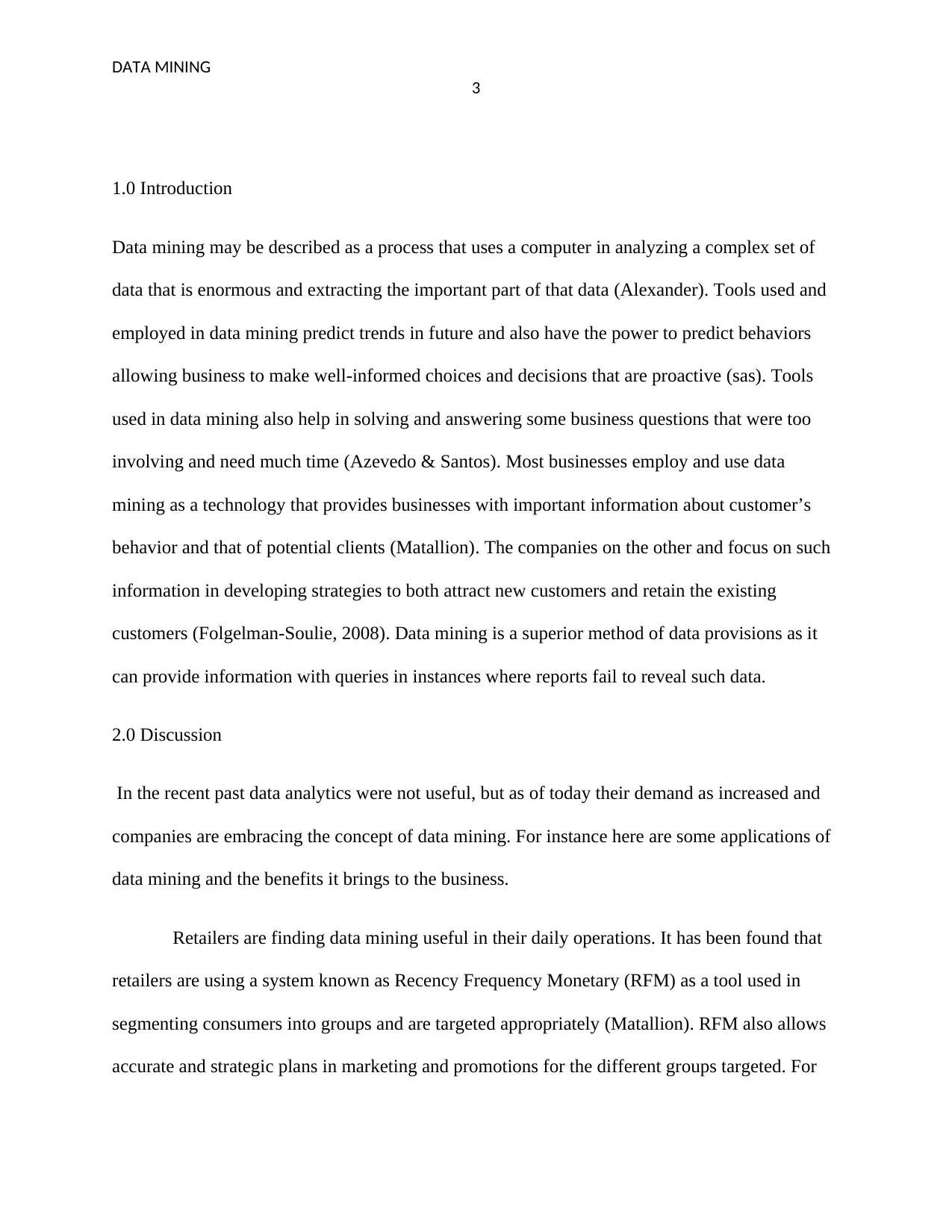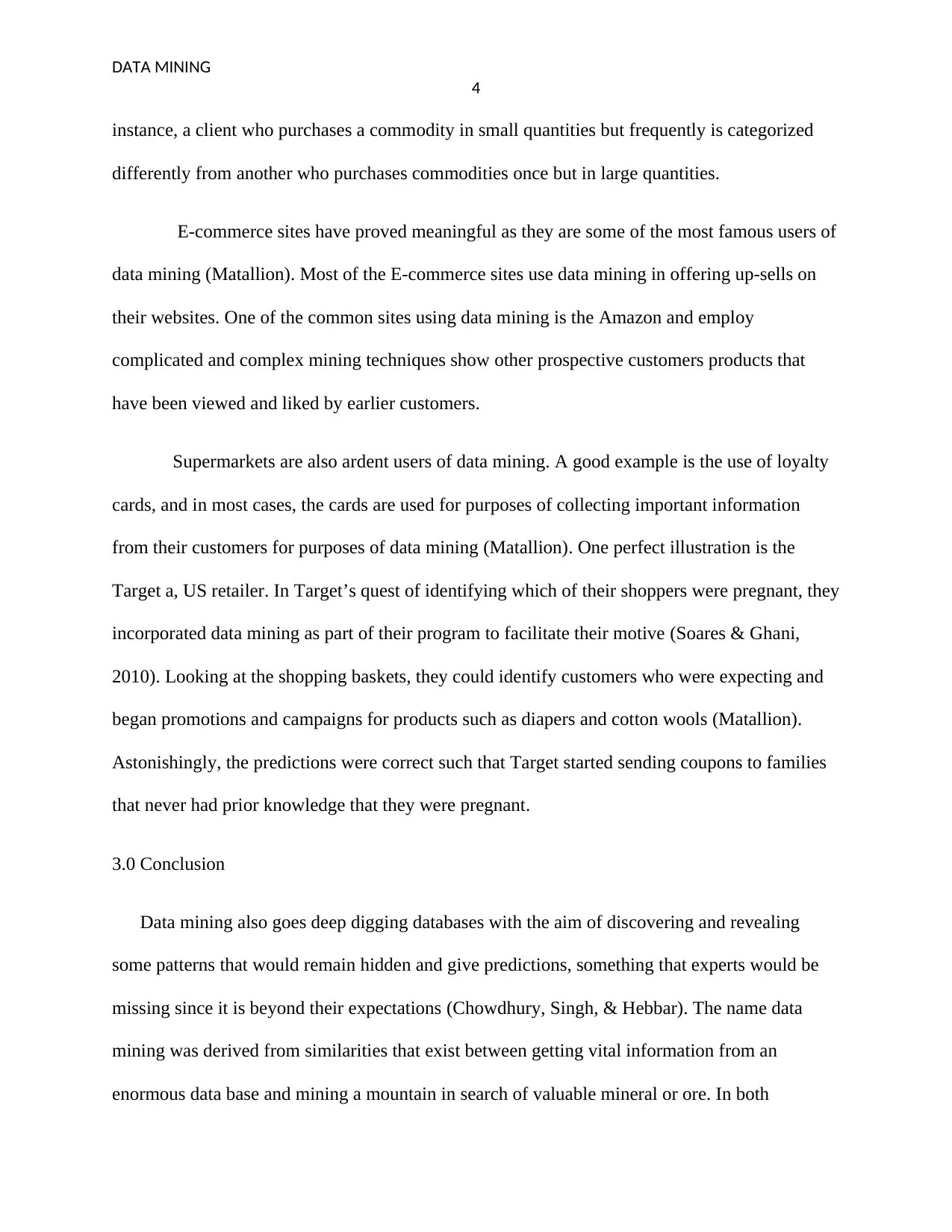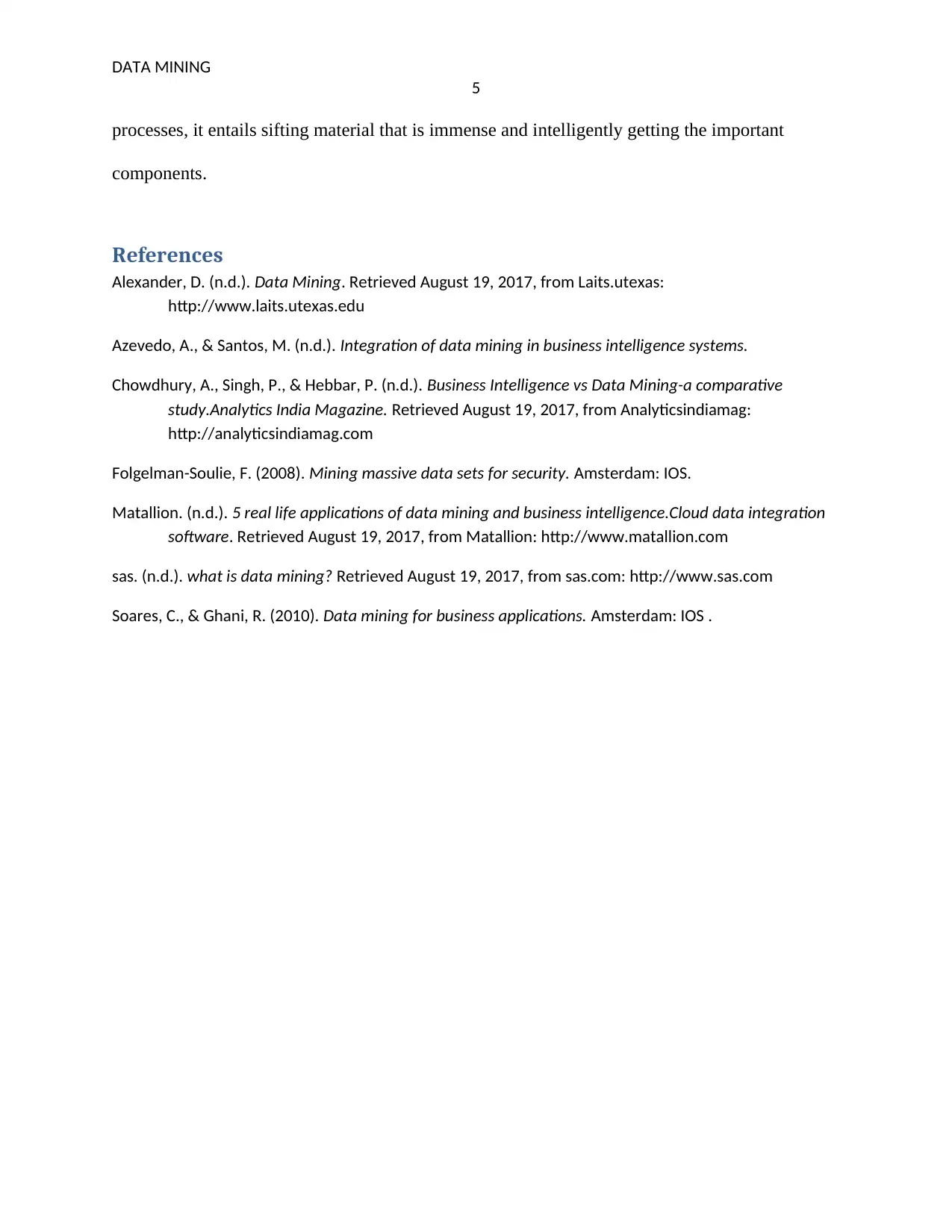Data Mining Assignment 1: Introduction, Discussion, and Conclusion
VerifiedAdded on 2020/03/13
|5
|832
|39
Homework Assignment
AI Summary
This assignment provides an introduction to data mining, defining it as a process that analyzes large datasets to extract valuable information and predict future trends. The discussion section explores real-world applications, focusing on how retailers use data mining through techniques like Recency Frequency Monetary (RFM) analysis to segment customers and tailor marketing strategies. It also examines the use of data mining by e-commerce sites, such as Amazon, to offer product recommendations, and by supermarkets, like Target, to identify customer needs and personalize promotions. The conclusion emphasizes data mining's ability to uncover hidden patterns and provide predictive insights, mirroring the process of extracting valuable components from a vast amount of data. The assignment includes references to support the information presented.

Running head: DATA MINING
1
Student ID
Student’s Name
Assignment 1
1
Student ID
Student’s Name
Assignment 1
Paraphrase This Document
Need a fresh take? Get an instant paraphrase of this document with our AI Paraphraser

DATA MINING
2
Contents
1.0 Introduction……………………………………………………………………………………………………………………………3
2.0 Discussion……………………………………………………………………………………………………………………………….3
3.0 References…………………………………………………………………………………………………………………………… 5
2
Contents
1.0 Introduction……………………………………………………………………………………………………………………………3
2.0 Discussion……………………………………………………………………………………………………………………………….3
3.0 References…………………………………………………………………………………………………………………………… 5

DATA MINING
3
1.0 Introduction
Data mining may be described as a process that uses a computer in analyzing a complex set of
data that is enormous and extracting the important part of that data (Alexander). Tools used and
employed in data mining predict trends in future and also have the power to predict behaviors
allowing business to make well-informed choices and decisions that are proactive (sas). Tools
used in data mining also help in solving and answering some business questions that were too
involving and need much time (Azevedo & Santos). Most businesses employ and use data
mining as a technology that provides businesses with important information about customer’s
behavior and that of potential clients (Matallion). The companies on the other and focus on such
information in developing strategies to both attract new customers and retain the existing
customers (Folgelman-Soulie, 2008). Data mining is a superior method of data provisions as it
can provide information with queries in instances where reports fail to reveal such data.
2.0 Discussion
In the recent past data analytics were not useful, but as of today their demand as increased and
companies are embracing the concept of data mining. For instance here are some applications of
data mining and the benefits it brings to the business.
Retailers are finding data mining useful in their daily operations. It has been found that
retailers are using a system known as Recency Frequency Monetary (RFM) as a tool used in
segmenting consumers into groups and are targeted appropriately (Matallion). RFM also allows
accurate and strategic plans in marketing and promotions for the different groups targeted. For
3
1.0 Introduction
Data mining may be described as a process that uses a computer in analyzing a complex set of
data that is enormous and extracting the important part of that data (Alexander). Tools used and
employed in data mining predict trends in future and also have the power to predict behaviors
allowing business to make well-informed choices and decisions that are proactive (sas). Tools
used in data mining also help in solving and answering some business questions that were too
involving and need much time (Azevedo & Santos). Most businesses employ and use data
mining as a technology that provides businesses with important information about customer’s
behavior and that of potential clients (Matallion). The companies on the other and focus on such
information in developing strategies to both attract new customers and retain the existing
customers (Folgelman-Soulie, 2008). Data mining is a superior method of data provisions as it
can provide information with queries in instances where reports fail to reveal such data.
2.0 Discussion
In the recent past data analytics were not useful, but as of today their demand as increased and
companies are embracing the concept of data mining. For instance here are some applications of
data mining and the benefits it brings to the business.
Retailers are finding data mining useful in their daily operations. It has been found that
retailers are using a system known as Recency Frequency Monetary (RFM) as a tool used in
segmenting consumers into groups and are targeted appropriately (Matallion). RFM also allows
accurate and strategic plans in marketing and promotions for the different groups targeted. For
⊘ This is a preview!⊘
Do you want full access?
Subscribe today to unlock all pages.

Trusted by 1+ million students worldwide

DATA MINING
4
instance, a client who purchases a commodity in small quantities but frequently is categorized
differently from another who purchases commodities once but in large quantities.
E-commerce sites have proved meaningful as they are some of the most famous users of
data mining (Matallion). Most of the E-commerce sites use data mining in offering up-sells on
their websites. One of the common sites using data mining is the Amazon and employ
complicated and complex mining techniques show other prospective customers products that
have been viewed and liked by earlier customers.
Supermarkets are also ardent users of data mining. A good example is the use of loyalty
cards, and in most cases, the cards are used for purposes of collecting important information
from their customers for purposes of data mining (Matallion). One perfect illustration is the
Target a, US retailer. In Target’s quest of identifying which of their shoppers were pregnant, they
incorporated data mining as part of their program to facilitate their motive (Soares & Ghani,
2010). Looking at the shopping baskets, they could identify customers who were expecting and
began promotions and campaigns for products such as diapers and cotton wools (Matallion).
Astonishingly, the predictions were correct such that Target started sending coupons to families
that never had prior knowledge that they were pregnant.
3.0 Conclusion
Data mining also goes deep digging databases with the aim of discovering and revealing
some patterns that would remain hidden and give predictions, something that experts would be
missing since it is beyond their expectations (Chowdhury, Singh, & Hebbar). The name data
mining was derived from similarities that exist between getting vital information from an
enormous data base and mining a mountain in search of valuable mineral or ore. In both
4
instance, a client who purchases a commodity in small quantities but frequently is categorized
differently from another who purchases commodities once but in large quantities.
E-commerce sites have proved meaningful as they are some of the most famous users of
data mining (Matallion). Most of the E-commerce sites use data mining in offering up-sells on
their websites. One of the common sites using data mining is the Amazon and employ
complicated and complex mining techniques show other prospective customers products that
have been viewed and liked by earlier customers.
Supermarkets are also ardent users of data mining. A good example is the use of loyalty
cards, and in most cases, the cards are used for purposes of collecting important information
from their customers for purposes of data mining (Matallion). One perfect illustration is the
Target a, US retailer. In Target’s quest of identifying which of their shoppers were pregnant, they
incorporated data mining as part of their program to facilitate their motive (Soares & Ghani,
2010). Looking at the shopping baskets, they could identify customers who were expecting and
began promotions and campaigns for products such as diapers and cotton wools (Matallion).
Astonishingly, the predictions were correct such that Target started sending coupons to families
that never had prior knowledge that they were pregnant.
3.0 Conclusion
Data mining also goes deep digging databases with the aim of discovering and revealing
some patterns that would remain hidden and give predictions, something that experts would be
missing since it is beyond their expectations (Chowdhury, Singh, & Hebbar). The name data
mining was derived from similarities that exist between getting vital information from an
enormous data base and mining a mountain in search of valuable mineral or ore. In both
Paraphrase This Document
Need a fresh take? Get an instant paraphrase of this document with our AI Paraphraser

DATA MINING
5
processes, it entails sifting material that is immense and intelligently getting the important
components.
References
Alexander, D. (n.d.). Data Mining. Retrieved August 19, 2017, from Laits.utexas:
http://www.laits.utexas.edu
Azevedo, A., & Santos, M. (n.d.). Integration of data mining in business intelligence systems.
Chowdhury, A., Singh, P., & Hebbar, P. (n.d.). Business Intelligence vs Data Mining-a comparative
study.Analytics India Magazine. Retrieved August 19, 2017, from Analyticsindiamag:
http://analyticsindiamag.com
Folgelman-Soulie, F. (2008). Mining massive data sets for security. Amsterdam: IOS.
Matallion. (n.d.). 5 real life applications of data mining and business intelligence.Cloud data integration
software. Retrieved August 19, 2017, from Matallion: http://www.matallion.com
sas. (n.d.). what is data mining? Retrieved August 19, 2017, from sas.com: http://www.sas.com
Soares, C., & Ghani, R. (2010). Data mining for business applications. Amsterdam: IOS .
5
processes, it entails sifting material that is immense and intelligently getting the important
components.
References
Alexander, D. (n.d.). Data Mining. Retrieved August 19, 2017, from Laits.utexas:
http://www.laits.utexas.edu
Azevedo, A., & Santos, M. (n.d.). Integration of data mining in business intelligence systems.
Chowdhury, A., Singh, P., & Hebbar, P. (n.d.). Business Intelligence vs Data Mining-a comparative
study.Analytics India Magazine. Retrieved August 19, 2017, from Analyticsindiamag:
http://analyticsindiamag.com
Folgelman-Soulie, F. (2008). Mining massive data sets for security. Amsterdam: IOS.
Matallion. (n.d.). 5 real life applications of data mining and business intelligence.Cloud data integration
software. Retrieved August 19, 2017, from Matallion: http://www.matallion.com
sas. (n.d.). what is data mining? Retrieved August 19, 2017, from sas.com: http://www.sas.com
Soares, C., & Ghani, R. (2010). Data mining for business applications. Amsterdam: IOS .
1 out of 5
Related Documents
Your All-in-One AI-Powered Toolkit for Academic Success.
+13062052269
info@desklib.com
Available 24*7 on WhatsApp / Email
![[object Object]](/_next/static/media/star-bottom.7253800d.svg)
Unlock your academic potential
Copyright © 2020–2025 A2Z Services. All Rights Reserved. Developed and managed by ZUCOL.





